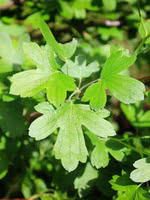Mon-Fri 9am - 5pm Mountain time
Western Snowberry vs Golden Currant
Ribes aureum
Symphoricarpos occidentalis
SOLD OUT
NOT AVAILABLE THIS SEASON - MIGHT RETURN
Golden Currant produces berries for jams, jellies, sauces and even pemmican. This currant bush is very dense, allowing for use as a hedge, windbreak, or wildlife habitat.
This plant is also a very popular rootstock to graft popular red and white currant varieties to. The resulting plants are taller, more productive, and easier to harvest.
Like the Common Snowberry, the Western Snowberry is a small shrub with pink flowers useful for feeding livestock and preventing erosion. Unlike the common species, however, the Western Snowberry is much more suited to wet conditions, capable of persevering through poor soil drainage and occasional flooding.
After the Snowberry's flowers have bloomed, it produces berries which often last on the plant through winter. These berries are toxic to humans, but livestock and local wildlife love them! Those hoping to attract wildlife to their property can plant Snowberry and expect to see animals foraging on it much later in the year than other plants.
Golden Currant Quick Facts
Western Snowberry Quick Facts
Toxicity: berries are toxic to humans

